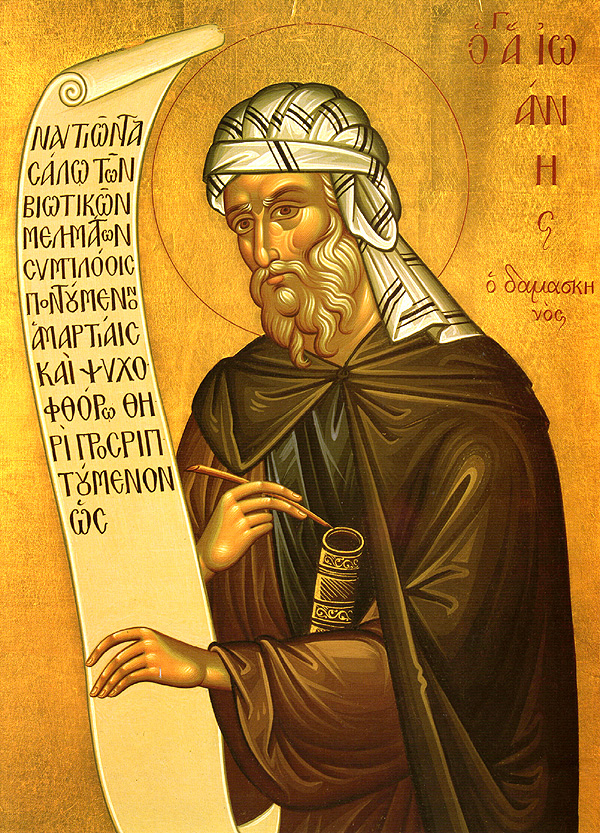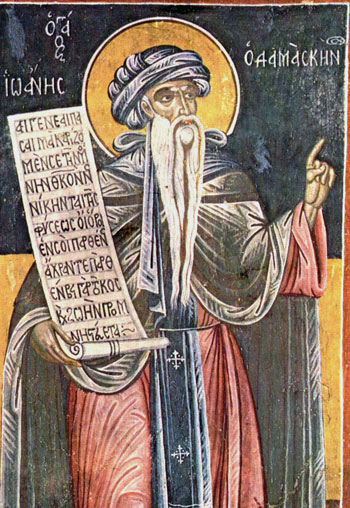
Catholic Saints
Saint John of Damascus (c. 675–749 AD), a monk and priest in the Monastery of Saint Sabbas near Jerusalem, stands as a luminary of the eighth-century Church, revered as the last of the Eastern Fathers and a Doctor of the Church for his eloquent defense of Christian doctrine amidst the rise of Islam. Born into a prominent Christian family in Damascus under Umayyad rule, he served as a high official before embracing monastic life, where his intellectual gifts flourished. Known as the “Golden Speaker” for his rhetorical prowess, John is celebrated for his Fountain of Knowledge, a comprehensive theological synthesis that countered heresies and articulated orthodoxy, and for his passionate defense of icons during the Iconoclastic Controversy, influencing the Second Council of Nicaea in 787 AD. His hymns, like the Easter Canon, enriched Eastern liturgy, blending poetry with profound theology. Living at the crossroads of Christian and Muslim worlds, his feast day is celebrated on December 4, and he was named a Doctor of the Church in 1890 by Pope Leo XIII, leaving a legacy as a bridge between traditions and a champion of faith through scholarship and song.
His feast day is celebrated on December 4.
Doctor of the Church
Born around 675 AD in Damascus, Saint John of Damascus emerged as a monk and scholar, defending Christian orthodoxy and enriching liturgy under the shadow of Islamic rule in the eighth century.
John was born circa 675 AD in Damascus, then the capital of the Umayyad Caliphate, into a wealthy Christian Arab family, the Mansur clan. His father, Sergius Mansur, served as a high-ranking official under Caliph Abd al-Malik, managing finances in a Muslim-ruled society tolerant of Christians. Raised in a bilingual environment of Arabic and Greek, John received an exceptional education, likely tutored by a Sicilian monk named Cosmas, who broadened his knowledge of theology, philosophy, and music.
Growing up amid the cultural richness of Damascus, John inherited his father’s role as a logothete (administrator), navigating the complexities of a Christian life under Islamic governance. This early exposure to diverse traditions and intellectual rigor shaped his later work, grounding him in a unique position to bridge Eastern Christianity with an emerging Islamic world.
Around 706 AD, John relinquished his secular career, possibly due to shifts in Umayyad policy under Caliph al-Walid I, and entered the Mar Saba Monastery near Jerusalem. Ordained a priest, he adopted a life of asceticism and scholarship under the guidance of Patriarch John V. The monastery, perched in the Judean desert, became his haven for contemplation and writing, free from the political pressures of Damascus.
This transition marked a profound shift, as John embraced the solitude that fueled his theological output. His monastic years honed his rhetorical skills—earning him the title “Chrysorrhoas” (Golden Stream)—and solidified his commitment to defending the faith, particularly as the Church faced new challenges from within and without its borders.
John emerged as a leading voice during the Iconoclastic Controversy, sparked by Emperor Leo III’s edict against religious images in 726 AD. Living outside Byzantine control, he boldly wrote three treatises, On the Divine Images, arguing that icons honored Christ’s incarnation, not idolatry. His works, circulated widely, bolstered resistance to iconoclasm and influenced the Second Council of Nicaea in 787 AD, which restored icon veneration.
His defense drew imperial wrath—Leo III reportedly forged a letter to frame John as a traitor, leading to his hand’s mutilation (later miraculously restored, per tradition)—but his location in Umayyad territory shielded him from direct persecution. John’s arguments, rooted in theology and scripture, cemented his role as a champion of sacred art, shaping Eastern Christian practice for centuries.
John’s masterwork, The Fountain of Knowledge, is a three-part theological summa: Philosophical Chapters (on logic), On Heresies (cataloging 103 errors), and An Exact Exposition of the Orthodox Faith (systematizing doctrine). Completed late in life, it synthesized Greek patristic thought, offering a comprehensive defense against heresies like Monophysitism and Nestorianism, and clarifying Trinitarian and Christological truths.
This encyclopedic effort, written in Greek, became a cornerstone for Eastern theology, influencing Byzantine scholars and later Western thinkers via Latin translations. Its clarity and depth earned John posthumous acclaim as the last of the Eastern Fathers, a title reflecting his role in preserving and articulating the Church’s intellectual heritage amid a shifting world.
John’s poetic genius enriched Eastern liturgy with hymns like the Easter Canon (“The Day of Resurrection”), still sung in Orthodox churches, and the Canon for Christmas. Blending theological depth with lyrical beauty, these compositions celebrated Christ’s mysteries and became staples of Byzantine worship, showcasing his mastery of Greek hymnography.
His musical contributions, possibly including chant reforms, complemented his theological work, uniting intellect and devotion. John’s hymns, paired with his treatises, made him a multifaceted figure whose artistry lifted the faithful, cementing his influence on the Eastern Church’s spiritual and cultural life.
John died on December 4, 749 AD, at Mar Saba Monastery, aged around 74, and was buried there, his tomb a site of veneration until lost to history. His feast day, December 4, honors a life of scholarship and sanctity. Named a Doctor of the Church in 1890 by Pope Leo XIII, he bridged Eastern and Western traditions, his works enduring as treasures of Christian thought.
Saint John of Damascus’s legacy lies in his defense of icons, theological synthesis, and liturgical poetry. Living at a cultural crossroads, he fortified orthodoxy against iconoclasm and Islam, influencing councils and hymnody. Revered as a “Golden Speaker,” his life exemplifies faith’s resilience, a beacon for scholars and believers across centuries.
“The whole earth is a living icon of the face of God.”
Born in Damascus.
Raised in Umayyad court.
Entered Mar Saba Monastery.
Became a monk.
Wrote against iconoclasm.
Authored On the Divine Images.
Completed theological summa.
Wrote Fountain of Knowledge.
Died at Mar Saba.
Named Doctor of the Church in 1890.

“The whole earth is a living icon of the face of God.”
Saint John of Damascus Quotes
“Show me the icons that you venerate, that I may understand your faith.”
“The Word became flesh, and the invisible became visible, so that we might honor Him through images.”
“Knowledge is the light of the soul, illuminating the darkness of ignorance.”
“The saints are the friends of God, and through them we draw near to Him.”
“Music is the language of the soul, lifting us to the divine harmony.”
“Heresy divides, but truth unites; for there is one Lord, one faith, one baptism.”